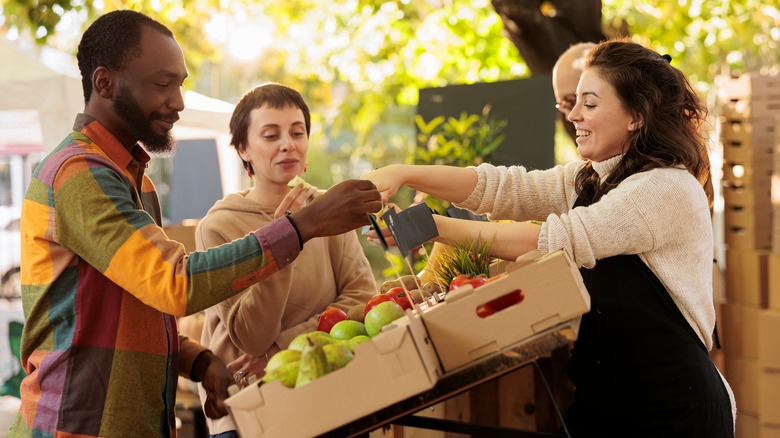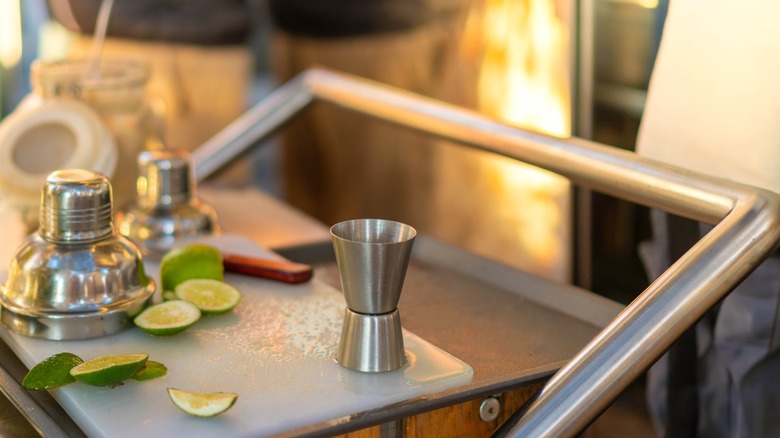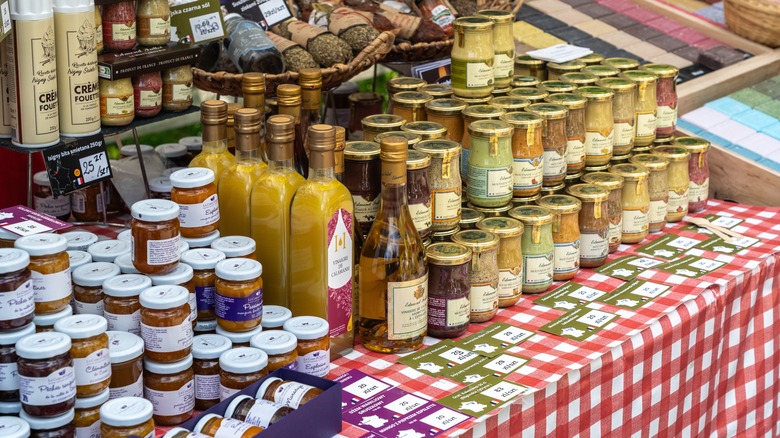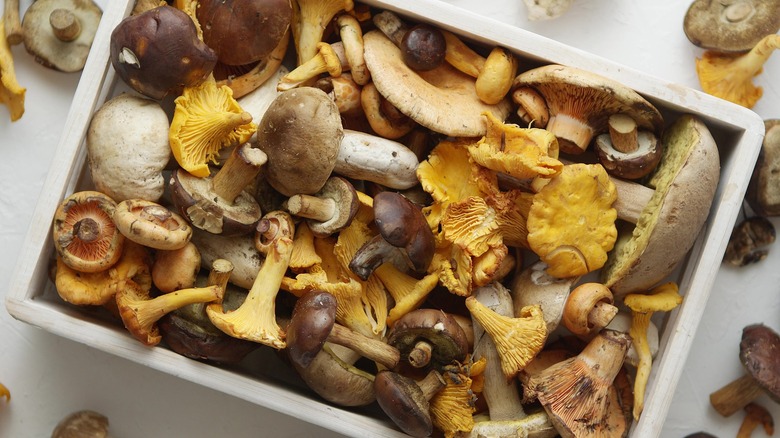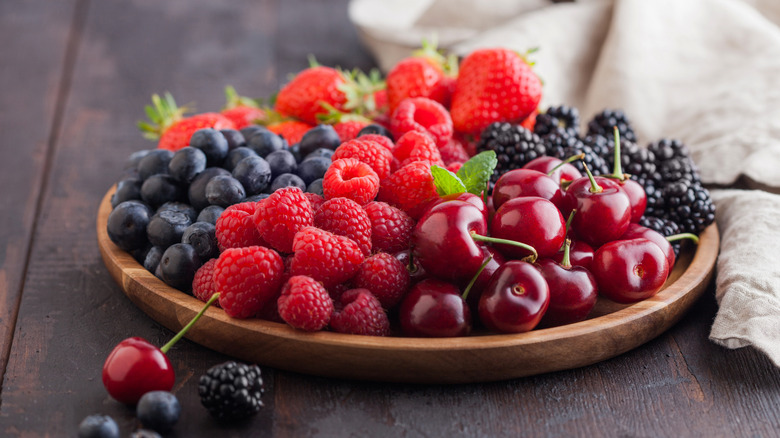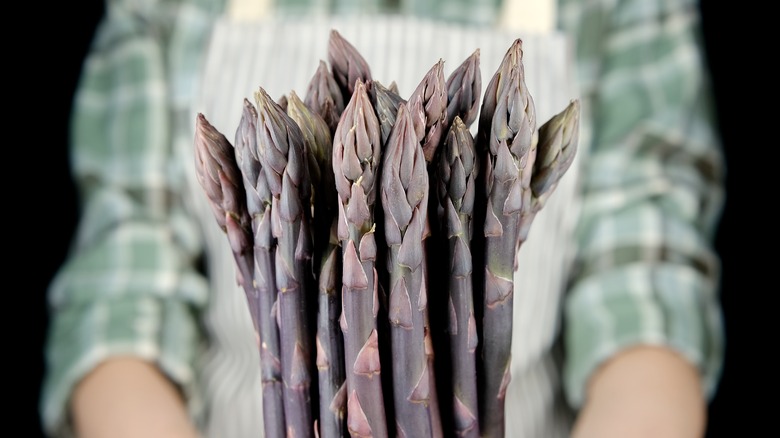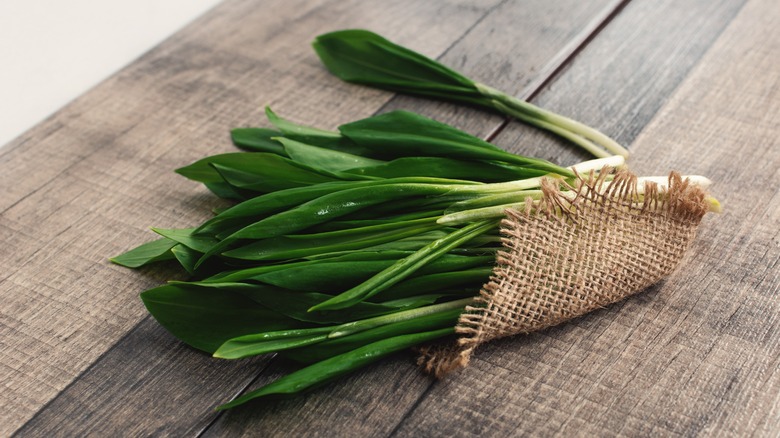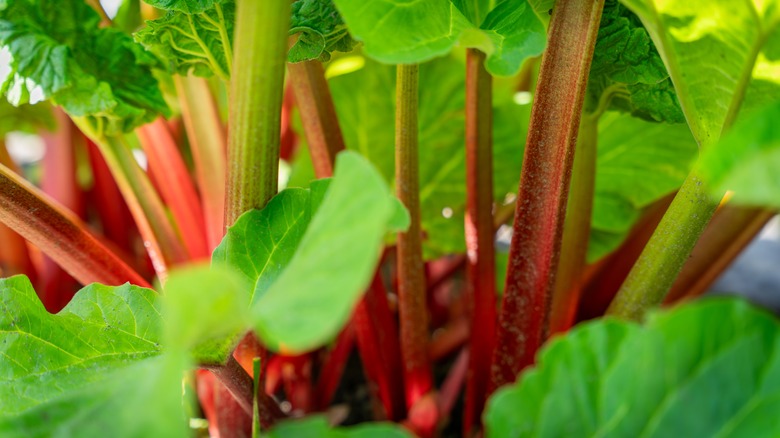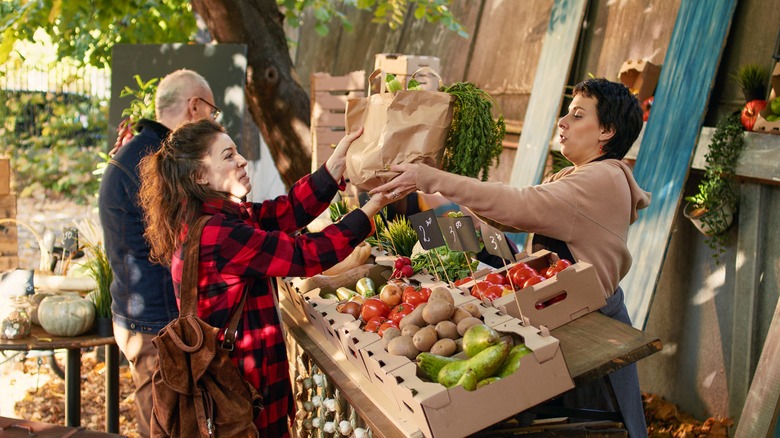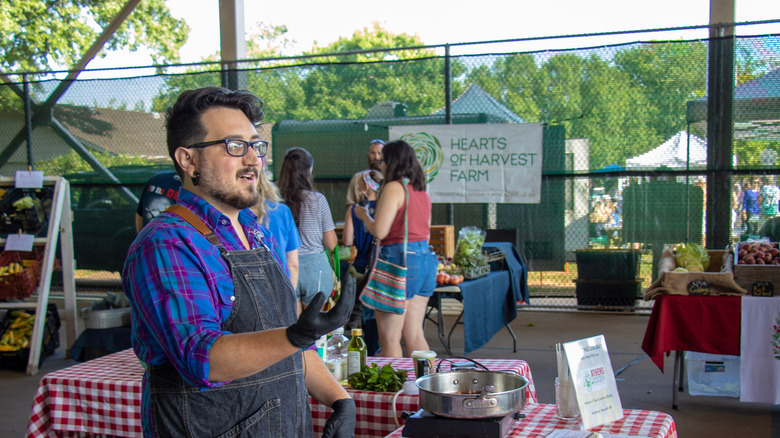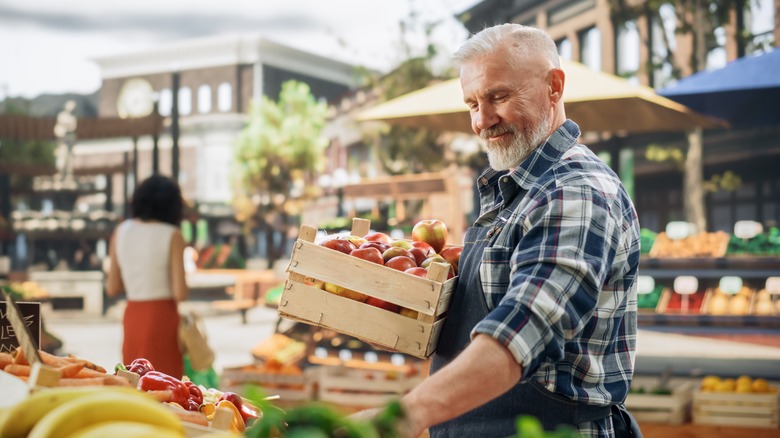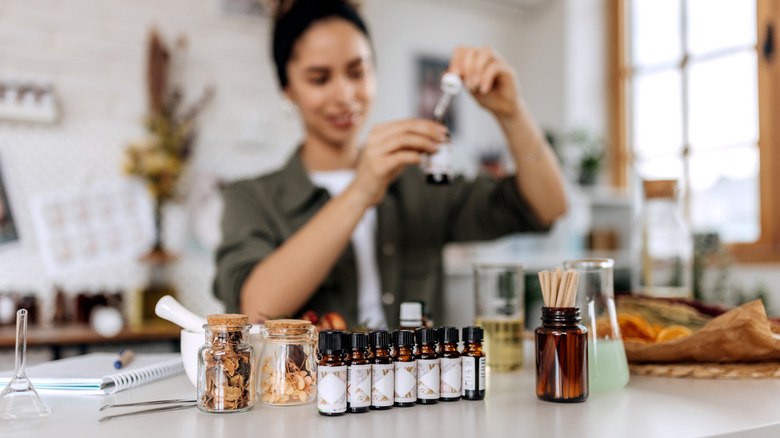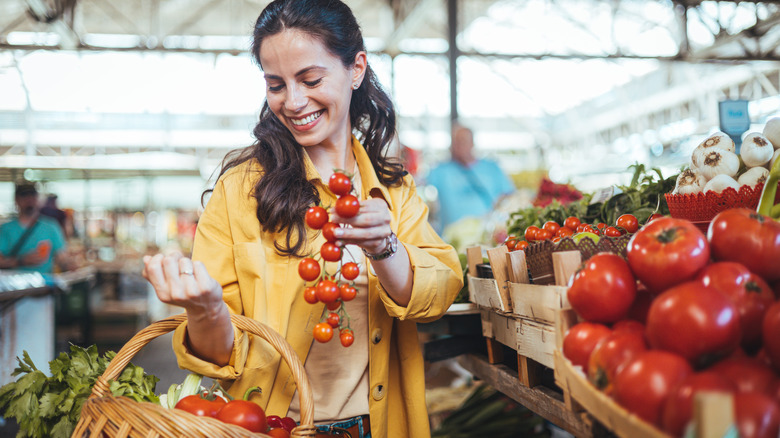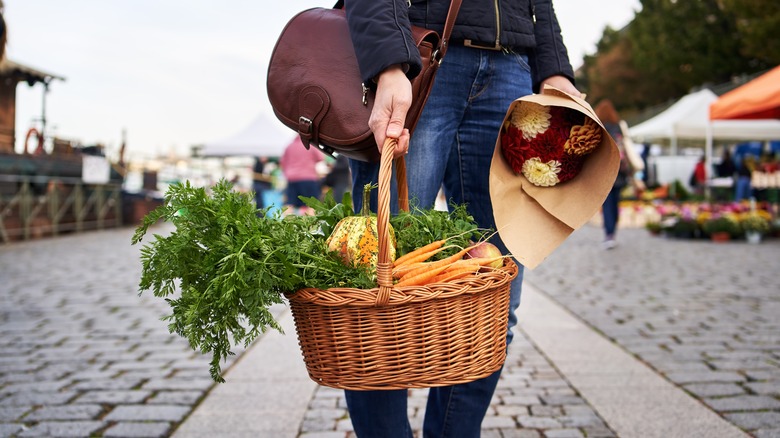Hidden Gems To Look Out For At Your Local Farmers Market
Nothing beats strolling through packed aisles of white tents and bursting produce displays, interspersed with gorgeous blossoms, fragrant berries, and the freshest cheeses. Many people consider visiting a farmers market as more than a shopping trip, but rather an activity in itself. Indeed, America has a long love affair with farmers markets, with the oldest one (Lancaster Central Market) dating back to the late 1800s.
Today, there are about 8,600 markets in the U.S. Some big cities have dozens, if not more, while small towns often have only one or two. That means there's always an opportunity to visit a farmers' market. But before you do, be sure to check out these farmers market tips and tricks to make the experience more enjoyable.
Farmers markets are known to offer amazingly fresh produce, meats, cheeses, eggs, herbs, and jams. It's also a fantastic place to find great coffee, locally brewed beer, bottled wine, or kombucha. What you may not know is how many other hidden gems you can find at your average local market. Here's just a small sampling.
Mixers, syrups, and bitters
Devoted barflies may wish to try making some of their favorite drinks on their own, and the farmers market is a perfect place to find the mixings to do it. Look for cocktail syrups made locally with fresh ingredients, for instance. These are perfect for both cocktails and mocktails, and usually look adorable on a bar cart in your dining room or kitchen. Look also for locally distilled liquors, liqueurs, and bitters. Farmers markets are also a good place to find more unconventional booze and beverages. Think drinking vinegars, fire cider, mead, and sparkling lemonade.
For the most part, farmers markets are staffed by small or family businesses, so the people running the stands are highly enthusiastic about their products. One of the most important farmers market pro tips is to ask the owner or worker about their ingredients. Not only are people usually delighted to tell you all about what's in their products and how to use them, but most will gladly give you a sample or two to help you choose.
Condiments
Condiments are an often underlooked kitchen staple, usually only noticed when you have one of those "Am I seriously out of mayo at a time like this?" moments. As such, you should always stay stocked, and the farmers market is a great place to make this happen. Most have a wide variety of condiments for sale, but shoppers may miss this in their pursuit of traditional produce, meats, and cheeses. That's a mistake, though, since freshly made condiments can elevate many meals, making them more delicious.
Look for freshly made mustard, salsa and chimichurri, pesto, hot sauce, and aioli. Specialty items such as pickled beets, sauerkraut, corn relish, and homemade dressings are all delicious as well. Jams and jellies are commonly found at farmers markets, as are maple syrup and honey. Be on the look out for all of these, and to make sure you're getting the best available, don't buy before sampling.
Mushrooms
Most grocery stores reliably carry three to five types of mushrooms: white, cremini, portabella, and often oyster or shiitake. However, that's the tip of the iceberg when it comes to edible mycology. At the farmers market, you'll find more options; it's fun to try different locally and ethically sourced varieties. Morels, lobster mushrooms, chicken of the woods, or chanterelles are all common finds. The mushroom scene is especially fantastic in the spring and fall. Depending on where you live in the United States, there may be dozens of kinds of edible wild mushrooms you just won't find at the store.
But the real hidden gem here is the mycology education. If you've ever wanted to learn to mushroom hunt, this is the place to start, as dedicated hunters are both enthusiastic and typically generous with their knowledge. They tend not to guard spots because gathering mushrooms begets more mushrooms (the spores fall off and spread when mushroom hunters bring them home). If you get really excited, you can even make spore prints and try to grow your own mushrooms from farmers market finds. Hardcore, but totally possible.
Make sure when you bring mushrooms home that you store them correctly. There are several ways to keep or preserve your mushrooms, so do some research beforehand to avoid wasting money. Storing fresh morel mushrooms, for example, include the fridge, freezer, or dehydrator, amongst other things.
Berries
Yes, you can find berries at the grocery store. No, they will not usually have that garden-fresh taste and texture. Berries at grocery stores must be able to withstand a lot of storage, especially if they come from far away (such as those blueberries and strawberries that hail from Argentina).
On the other hand, farmers market berries are picked at the peak of ripeness. Since farmers know they can move them right away at markets, they can harvest them when they're at maximum flavor, super sweet with soft and juicy textures as opposed to that refrigerator-firm feel. Depending on your state, you may also find more unusual berries. The Pacific Northwest, for example, is known for loganberries, boysenberries, marionberries, olallieberries, tayberries, and more. In the Northeast, you'll find dark blue, oval-shaped honeyberries.
If you can, always get fresh berries at the farmers market. Look for firm but brightly colored berries that have little mush or juice coming through the sides of the baskets. Once you take them home, make sure to utilize these berry storage tips for longer lasting berries.
Hard-to-find veggies
Specialty veggies often can't be found at grocery stores, especially if they have a short shelf life or season. Think purple asparagus, red carrots, or black raspberries. They have such a short growing season that farmers choose to sell them directly at markets rather than set up supply chains, because produce can travel so quickly to market, often the same day.
Plus, farmers not only have hard-to-find veggies on hand, they also can educate you about how to use them. Many of these produce items are unique, which means they deserve special treatment in the kitchen. Wild or specialty berries may pair well with certain flavors in baked goods, while certain types of vegetables may take better to roasting versus blanching.
While you're busy sampling produce, pick the vendor's brain about storage, cooking, and serving suggestions. Make sure to note any wine or meat pairings that work well too. It can be useful to bring a notebook and a pen.
Ramps and garlic scapes
Alliums are excellent for flavoring soups, stews, meats, and more. Unfortunately, the varieties available at the store are usually limited: onions, shallots, garlic, and chives. More unusual varieties are delicious but hard to find at the grocery store. Where you do find them, you may pay a serious upcharge for low-quality items that won't improve your cooking.
Instead, head to your local farmers market and you'll find hidden gems such as ramps, wild garlic, elephant garlic, and garlic scapes. Elephant garlic has huge cloves that taste more mild than the regular variety, and are closer to the size of an onion than a traditional head, hence the name. (Note: This writer's in-laws were once elephant garlic farmers and can attest to its exquisite deliciousness, which is why it's now out in her garden).
Ramps are an ephemeral spring produce that you may only find if you follow certain farmers markets for alerts. Scapes are grown from traditional garlic, and simply mean the top of the garlic head, a long stem and flower bud that forms before the garlic blooms. Wild garlic, which grows in woodlands in springtime, has a bulb much like regular garlic, but a milder taste. You can also eat the leaves.
Rhubarb
Rhubarb is a time-honored garden vegetable, a perennial in cooler climates and an annual in warmer ones. It bursts from the ground with bright stalks, ranging from red to pink to green. These stalks are edible, and they are prized for making pies and jams. (Do note that the leaves are poisonous, however, so if you grow it yourself, always remove them well below where they start).
Unfortunately, rhubarb is somewhat hard to find at the grocery store. When you do see it, it's often chopped up, bagged, and frozen, which isn't the freshest way to use it. Even when you find fresh stalks, they are often larger and thicker. The smaller stalks are sweeter and more tender, making them better for jams and pies. That's when you can even find it; unless you grow it yourself, you're often out of luck.
But this spring plant is usually easy to find at the farmers market, since it grows abundantly when it's in season. Look for stalks that are bright, firm, and shiny for the best cooking results.
Produce in general
It's a myth that farmer's market produce is more expensive than what you'll find at the grocery store. In fact, you're unlikely to pay more, according to a report published in The Atlantic. Because you don't have to pay the store's upcharge and the food doesn't need to be transported and refrigerated as long, you can save by buying straight from the farmer. If you enjoy getting your vegetables from your local market, by all means, do it.
The only exception is your basic brassicas (broccoli, cabbage, etc.), potatoes, and onions, which are easy to mass produce organically and may be cheaper. These grow for much of the year and store for long periods of time, plus have little variation, so you're likely to save money. However, greens, mushrooms, berries, and corn are almost always better and fresher options. In general, fruits and veggies lose nutritional value steadily between picking and eating. Freezing at peak ripeness helps maintain nutrients, but buying fresh at the grocery store where produce is older often means a lower level of vitamins and minerals.
When you buy produce of any kind at the farmers market, make sure to store it carefully. Because it's picked closer to its actual ripeness, it is closer to spoiling if you're not careful. Look up the best ways to store individual products. You might be surprised to discover, for example, that Brussels sprouts are best stored on the stem until you're ready to use them.
Cooking demonstrations and nutritional education
Learning about food is time-consuming. Taking cooking classes is expensive, and spending hours researching local ingredients is also labor-intensive. But at the farmers market, vendors often put on demonstrations for free in order to promote their products. This is a great way to teach little ones the value of good food and to learn new techniques in the kitchen.
Talking to farmers and vendors while sampling and shopping is always useful, of course. However, cooking demonstrations and nutritional education are usually more structured, planned well ahead of time, and advertised through farmers market newsletters and email blasts. There, you can learn to cook a specific ingredient that's in season, or figure out when to source local ingredients for a holiday meal.
If you're a fitness fanatic, you're in luck. Some farmers markets have fitness demonstrations as well. If you're trying to up your health game, check those out as well as the cooking and nutrition demos.
Farmer education
Farmers markets have been growing steadily at about 7% per year over the past several decades. If you have an interest in local farming, this is a good place to learn about it or invest in your business idea. Not only can you ask vendors in your space how they got started, you can also head to the website of a specific market or your state's farmers market association to get resources and materials.
One of the best things about farmers markets is how much they support local businesses. They serve a huge swath of the community and help bring nutrition information and local food to underserved families, which is great for those who are philanthropically minded. Plus, they offer free advertising for farms and businesses through their newsletters, vendor directories, pamphlets at entrances, and features in area publications. Whether you have already launched your biz or are putting a plan together, you can count on local markets to help you get your name out.
There's no need to get fully "ready" before you start selling, either. A small investment of $20-$50 (possibly higher, depending on the market) may be worth it. As long as you have your license, you can start selling to crowds, learning what they like and dislike, and chatting with other vendors all weekend long.
Wellness products
Self-care is a buzzword these days, but it genuinely is important. Keeping yourself and your family calm and healthy is one of the best ways to live life, and farmers market wellness products can help you get there. Many vendors are well-educated and spend a good amount of time curating products to suit their clients' needs. Others can advise you on the best use of honey or hemp products, or they may choose a specific ingredient that is their "thing," such as saffron or lavender. Soaps, shampoos, lotions, essential oils, and creams are also available at many farmers markets.
You should always ask your physician or herbalist before introducing a wellness product into your routine. This is especially important if you are pregnant, trying to get pregnant, nursing, or have a health condition. However, if you get the go-ahead, you'll find many natural products at your local farmer's market. Think essential oils, salves, tinctures, and teas. Vendors will not only sell you the product, they'll educate you about how to use it and should be able to tell you any potential risks too.
Plants and flowers
You'll often find lots of plants at farmers markets. Veggie starts (the seedlings that you put in the ground in spring) are particularly popular. Think greens, corn, peppers, potatoes, tomatoes, broccoli, and so forth. Herb starts are another common find, and many are evergreen (think lavender or thyme), while others will self-seed if you leave the heads on (basil and cilantro). In appropriate climates, you may even find berry plants for sale.
More of a garden plant person? Look for showy annual and perennial plants, such as pansies or black-eyed Susan. This is known as "nursery stock," and is a great alternative to big garden centers that are likelier to use pesticides than small growers. If you want to be sure, just ask if the plant is organic. Also, some markets have houseplants for sale. At the holidays, you'll often find Christmas trees, wreaths, and garlands. Whether you get better prices on trees really depends on the farming economics that rule that year, but often, you can skip the grocery store surcharge.
Farmers markets are also amazing places to find gorgeous bouquets and cut flowers for prices equivalent to the grocery store, but much fresher. Often you'll even pay less because you're buying directly from the grower.
Additional vending spots
You may think of the weekly farmers market as the only place to find that homemade cinnamon bun that makes your heart skip a beat, but it's not so. Most vendors are, in fact, small businesses that must make their living by selling at lots of different outlets. If you find a vendor you love, find out where else they're vending. Some attend many different markets, while others sell at local grocery stores or have their own roadside or on-site farmstands. Just like that, you can pick up that favorite cinnamon roll any day of the week.
They will often tell you where else they sell, so you could possibly find somewhere closer to home or at a better time for your schedule. Even when they don't sell at particular markets, vendors are usually happy to fill you in, and you're likelier to find the tiny hidden gem markets scattered throughout your city.
Other farmers markets
Unless you've lived somewhere for a while and have word of mouth on your side, it can feel a little tricky to find other farmers markets. You can certainly check out online directories to find markets in your area. But it can be dicey when you're searching in a new area without a frame of reference. Since farmers markets are scattered throughout the city, often tucked away in small areas you'll never walk past, and only once a week (or sometimes twice monthly), they're hard to hunt down.
Happily, one of the best places to find out where the markets are hidden is at a farmers market! Ask vendors or staff about other locations. You may even discover where to find mobile markets in your neighborhood. These come to different neighborhoods to help narrow the gap between who can and can't find access to locally sourced and healthy food. That's another thing to ask vendors and staff about, or perform a Google search on "mobile markets [your area]."
